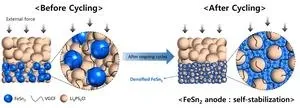(Press-News.org) The KERI's research on anode materials for solid-state batteries (SSBs), conducted in collaboration with Kumoh National Institute of Technology and Inha University, has been selected as the cover article of a world-leading journal in the energy field.
The SSBs have replaced the combustible liquid electrolyte that transfers ions between the anode and cathode with a solid electrolyte, significantly reducing the risk of fire or explosion. However, SSBs, due to their 'solid' nature, require much advanced technology, such as ensuring electro-chemo-mechanical stability during the charging and discharging processes. In particular, since the anode has a significant impact1) on the charging rate and lifespan of the battery, the choice of material is extremely important.
1) Anode: In secondary batteries, the anode functions to store and release lithium ions that migrate from the cathode (+).
Currently, 'Li-metal' is the most extensively researched anode material for SSBs. However, in the case of Li-metal, repeated charging and discharging lead to 'dendrite growth,' where lithium grows in tree-like structures on the surface. This phenomenon can result in internal short circuits, threatening the battery's lifespan and stability. Besides Li-metal, silicon anode materials are also available; however, they face several challenges, including low electronic and ionic conductivity, as well as cracks caused by volumetric expansion.
The anode materials proposed by KERI and the university team this time are tin(Sn)-based2) alloy materials, specifically 'FeSn2.' The research team identified through detailed mechanical property analysis that FeSn2 exhibits a characteristic of particle size reduction due to recombination reactions during repeated charging and discharging. This confirms that in SSBs, the contact between the internal solid particles is maintained for a long period of time, resulting in a dense and uniform electrode. Even in environments with external stimuli, FeSn2 exhibits high elasticity and deformation energy, ensuring good electrochemical stability without cracking.
2) Tin: A metallic element with the symbol Sn, atomic number 50, group 14, period 5 of the periodic table. Due to its low melting point, high workability, and stability, it has been one of the longest-used metals in human history. Today, more than 50% of tin is used as solder in the manufacture of electronic circuits, and other uses include storage containers, utensils, and PVC stabilizers..
The research team developed a test 'SSB full cell3)’ to validate the technology, utilizing ▲FeSn2 anode ▲NCM622 (nickel 6, cobalt 2, manganese 2 combination) cathode ▲sulfide solid electrolytes (Li6PS5C1). As a result, an areal capacity of 15.54 mAh/cm² was achieved, which is five times higher than that of conventional lithium-ion batteries. Additionally, high-rate charging and discharging were conducted for over 1,000 cycles under 3-minute (20C current density) and 6-minute (10C current density) conditions, achieving a capacity retention of over 70-80%.
3) Full cell : There are two types of test cells that are created to evaluate electrochemical properties: full cells and half cells. A full cell is a complete cell that includes both anode and cathode, allowing for the measurement of the overall battery performance. A half cell, on the other hand, uses only one electrode as the working electrode while employing a reference electrode for the other, enabling detailed analysis of the electrochemical properties of a specific electrode.
In addition, the research team evaluated the performance of the FeSn2 anode in SSBs by applying it to a prototype 'pouch cell' format. A high energy density of over 255 Wh/kg4) was recorded, demonstrating its commercial potential.
4) Commercial Li-ion batteries typically have an energy density in the range of 200 to 300 Wh/kg.
Yoon-Cheol Ha, Director of the Next Generation Battery Research Center at KERI, stated, "Our achievement is significant as it breaks away from the conventional focus on Li-metal and silicon in the research of anode materials for SSBs, demonstrating the great potential of tin-based alloy anode materials." Additionally, Professor Cheol-Min Park of Kumoh National Institute of Technology expressed his ambition, stating, "Through the development of stable high-performance anode materials that surpass existing limitations, we aim to contribute to the commercialization of non-flammable SSBs."
This research result has been recognized for its excellence and published as a cover article in the October issue of Joule, an international journal ranked in the top 1% of journal citation indicators (JCR). The Joule is a leading journal in the energy field and a sister journal to Cell, which is considered one of the top three journals in the scientific field, alongside Nature and Science. It is a world-class journal with an impact factor (IF) of 38.6.
The corresponding authors of the paper are Yoon-Cheol Ha, Director of the Next Generation Battery Research Center at KERI, Professor Cheol-Min Park from the Department of Materials Science and Engineering at Kumoh National Institute of Technology, and Professor Ki-Joon Jeon from the Department of Environmental Engineering at Inha University. Additionally, the first author is Young-Han Lee, a doctoral student in the Department of Materials Science and Engineering at Kumoh National Institute of Technology. The co-authors of the paper include Jeong-Hee Choi, Director of the Battery and Materials Processing Research Center at KERI, Professor In-Chul Choi from the Department of Materials Science and Engineering at Kumoh National Institute of Technology, as well as researchers Do-Hyeon Kim (doctoral student) and Jeong-Myeong Yoon (doctoral student).
<KERI is a government-funded research institute under the National Research Council of Science and Technology of the Korean Ministry of Science and ICT.>
END
KERI’s innovation in anode materials for solid-state batteries selected as a cover article
2024-10-22
ELSE PRESS RELEASES FROM THIS DATE:
A visit from the stork brings genomic hope for this endangered species
2024-10-22
A Visit from the Stork Brings Genomic Hope for this Endangered Species
A new genomic study of the endangered Oriental Stork reveals that the population's genetic health is still surprisingly strong, with high genetic diversity and low levels of inbreeding. This is an uncommon finding in most endangered species populations, which makes it more difficult to rescue those species from extinction. Thus, despite the human-caused decline in the Oriental stork numbers, the findings in this study provide hope for the species' long-term ...
Study uncovers the true burden of asthma in African pupils, highlighting need for better access to asthma diagnosis and care
2024-10-21
Peer reviewed | Observational study | People
Rapid urbanisation and population growth in sub-Saharan Africa has increased the incidence of asthma in young people, but the lack of diagnosis and care means that many young people are suffering from untreated symptoms of asthma, according to research from Queen Mary University of London.
The team who led the study, whose pioneering research on the impact of pollution on lung health was instrumental in introducing the Ultra Low-Emission Zone (ULEZ) in London, are calling for better access to asthma diagnosis and care in areas of ...
A remote-controlled car for cancer immunotherapy
2024-10-21
OCTOBER 21, 2024, NEW YORK – Ludwig Cancer Research scientists have devised new types of chimeric antigen-receptor (CAR) T cells—a type of cancer immunotherapy—that can be switched on to varying degrees of intensity and then switched off on demand with existing drugs. The design and preclinical evaluation of the CAR-T cells, led by Melita Irving and Greta Maria Paola Giordano Attianese of the Lausanne Branch of the Ludwig Institute for Cancer Research, is detailed in this week’s issue of the Proceedings of the National Academy of Sciences.
“CAR-T cells are already used today to treat a number of blood cancers, but ...
New ice core data provides insight into climate ‘tipping points’ during the last Ice Age
2024-10-21
CORVALLIS, Ore. – A changing climate triggers a sudden shift in ocean circulation, creating weather havoc and plunging Earth into an abrupt new Ice Age.
It sounds like the basis for a Hollywood blockbuster - the 2004 science fiction disaster film “The Day After Tomorrow,” has similar plot lines – but it’s actually a scenario that played out multiple times during the last Ice Age, which ended more than 11,000 years ago.
Just published research from multiple ice cores collected across Greenland with data spanning up to 120,000 years provides new understanding of these abrupt events, how they unfold and what that might ...
Being part of a ‘civilization’ only reduces violence if you’re a woman in ancient Andes populations
2024-10-21
The extent to which “civilization” heightens or lessens the likelihood of violent conflict throughout human history has remained one of the most enduring questions among anthropologists. But a new collaborative study of archaeological groups from the Andes region of South America suggests that being part of a centrally organized state society is only part of the equation.
“Our findings suggest that being in a ‘civilization’ may reduce violence, but only for women, and only slightly then,” ...
Gladstone to present 2024 Ogawa-Yamanaka Stem Cell Prize to Neuroscientist Rusty Gage
2024-10-21
SAN FRANCISCO—Neuroscientist Rusty Gage, PhD, will be the recipient of the 2024 Ogawa-Yamanaka Stem Cell Prize, awarded by Gladstone Institutes. He was selected for pioneering stem cell biology of the central nervous system and the use of reprogrammed cells to study age-related neurodegenerative disease and psychiatric disorders.
Gage is a professor in the Laboratory of Genetics at the Salk Institute for Biological Studies, where he also serves as the Vi and John Adler Chair for Research on Age-Related Neurodegenerative Disease. He was president of the Salk Institute from 2018 to 2023.
Over the course of his scientific career, Gage has made several paradigm-shifting ...
A blueprint for mapping melting ice sheets
2024-10-21
Researchers in the Stanford Radio Glaciology lab use radio waves to understand rapidly changing ice sheets and their contributions to global sea-level rise. This technique has revealed groundwater beneath Greenland, the long-term impacts of extreme melt, a process that could accelerate ice sheet mass loss in Antarctica, the potential instability of an ice sheet that could raise sea levels by 10 feet, and more.
Now, PhD students within the group have created an open-source tool that others can use to make ice-penetrating radar systems, core instruments ...
People hate stories they think were written by AI. Even if they were written by people
2024-10-21
Stories written by the latest version of ChatGPT were nearly as good as those written by human authors, according to new research on the narrative skills of artificial intelligence.
But when people were told a story was written by AI — whether the true author was an algorithm or a person — they rated the story poorly, a sign that people distrust and dislike AI-generated art.
“People don’t like when they think a story is written by AI, whether it was or not,” said Haoran “Chris” Chu, Ph.D., a professor of public relations at the University of Florida and co-author of the new study. “AI is good at writing something that is consistent, ...
From Houston to Scotland: Seed grants boosting shared energy solutions and innovations
2024-10-21
HOUSTON, Oct. 21, 2024 – The University of Houston and Scotland’s Heriot-Watt University have awarded seed grants to six innovative energy projects as part of their transatlantic research collaboration. The projects, which bring together researchers from both universities, focus on cutting-edge solutions ranging from advanced hydrogen sensing technology to converting waste into sustainable products.
“This partnership is rooted in a shared commitment to advancing research that supports a just energy ...
AI-assisted colonoscopy increases polyp and adenoma detection in routine screening
2024-10-21
Embargoed for release until 5:00 p.m. ET on Monday 21 October 2024
@Annalsofim
Below please find summaries of new articles that will be published in the next issue of Annals of Internal Medicine. The summaries are not intended to substitute for the full articles as a source of information. This information is under strict embargo and by taking it into possession, media representatives are committing to the terms of the embargo not only on their own behalf, ...






